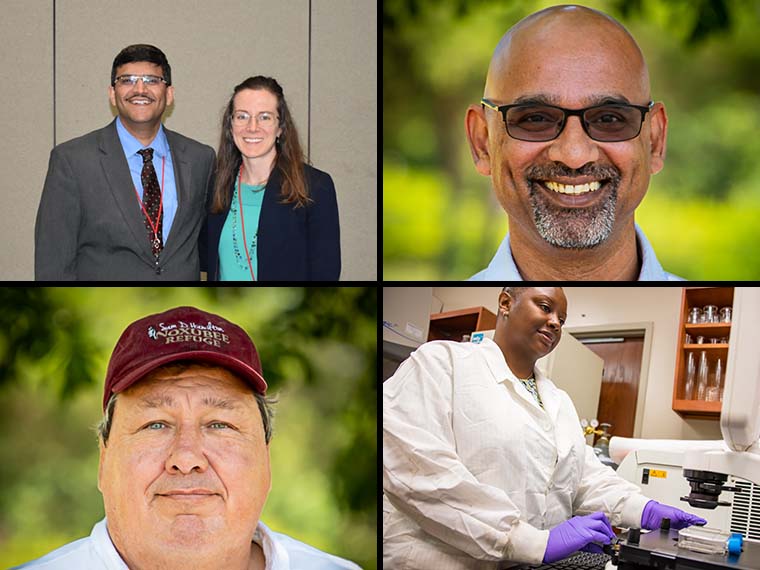The information presented on this page may be dated. It may refer to situations which have changed or people who are no longer affiliated with the university. It is archived as part of Mississippi State University's history.
FROM BONE HEALING to heart health to even protecting honeybees, the University of Mississippi Medical Center, or UMMC, is a strategic partner of MAFES, focused on advancing health and wellness through research in the Magnolia State.
Dr. Lauren Priddy, assistant professor in the Department of Agricultural and Biological Engineering, works with UMMC experts to find better paths to bone healing. She has partnered with Dr. Amol Janorkar, a professor in the Department of Biomedical Materials Science at UMMC.
The team is working to develop drug delivery approaches to combat bone infection, known as osteomyelitis, and enhance bone healing.
"We use collagen-based composite biomaterials containing elastin-like polypeptide (ELP) and bioglass to deliver a bone-building protein and antibiotic," Priddy said. "By controlling the amount of the collagen, ELP, and bioglass in the biomaterial, we can tailor mechanical strength of the hydrogels and control the release of the protein and antibiotic, which is ideal for prolonging their effects at the site of the injury and/or infection."
In the initial pilot study, funded by a seed grant from the UMMC Office of Research Intramural Research Support Program, the team's hypothesis was that the biomaterial containing the antibiotic doxycycline would reduce infection.
"We found the doxycycline had a small, although not significant, effect on bone and soft tissue infection in vivo," said Priddy, who noted the team submitted a proposal for an expanded study to the NIH in March.
The study was also the first time the team explored antimicrobial effects beyond one day post treatment.
"We studied the model four weeks past the onset of treatment and we're seeing the same effects that are present at one day. The bacterial reduction is still present at day 28," Priddy said.
Priddy said the work has allowed her to expand her research to evaluate novel biomaterial strategies to combat bone infection.
"Through Amol's invitation, I've had the opportunity to visit UMMC to present my work and network with UMMC colleagues at the Work in Progress Meeting in 2017 and the UMMC-MSU Research Summit in 2019. Additionally, I've volunteered with the Perry Initiative Outreach Program, for high school girls interested in a career in orthopedics," Priddy said.
The team includes Dr. Jason Griggs, professor and chair of the Department of Biomedical Materials Science; Dr. Michelle Tucci, professor of anesthesiology; and Dr. Lir-Wan Fan, associate professor in the Division of Newborn Medicine, all with UMMC. MSU students involved in the research include Anna Rourke, a May 2020 graduate in biological engineering, and Vicki Scites Renner, a third-year student in the Doctor of Veterinary Medicine program in the College of Veterinary Medicine, whose work as a participant in CVM Summer Research Experience was supported by an NIH T35 training grant.
In addition to his work with Priddy, Janorkar also partnered with Dr. Natraj Krishnan, MAFES entomologist and associate professor and Dr. Jeffrey Harris, MAFES entomologist and associate extension and research professor both in MSU's biochemistry, molecular biology, entomology and plant pathology department, to use an emerging drug-delivery system to help honeybees in the fight against the small but mighty varroa mite.
In another study, Dr. LaShan Simpson, associate professor in the Department of Agricultural and Biological Engineering, is partnering with Dr. Michael Garrett, professor, Department of Pharmacology and Toxicology, to study how primary cells react to a high-phosphate environment.
The team is studying how the cellular shift from vascular smooth muscle cells to an osteoblast, or bone-like, structure can impact the onset of cardiovascular disease.
Simpson said vascular calcification, a major contributor to cardiovascular disease, results in a phenotypic switch of vascular smooth muscle cells into osteoblast-like cells. She's hoping a protein might interrupt this switch.
"In our preliminary studies, we demonstrate that treatments with sclerostin, a protein produced in osteocytes, or bone cells, inhibits calcification of vascular smooth muscle cells in vitro and protects these cells from switching to osteoblast-like cells," Simpson explained. "While our findings suggest that sclerostin may either be used to prevent or treat vascular calcification at the cellular level, the specific mechanisms through which this protein functions remain unknown. We hope to better understand that."
The team will perform high throughput RNA sequencing of calcified vascular smooth muscle cells. This will be mapped to the human genome to determine the genes differentially expressed in calcified vascular smooth muscle cells.
"Through RNA sequencing, we hope to identify the genes that make this shift in a high-phosphate environment and from there we can identify the signaling pathways and figure out what's initiating the change in those genes," Simpson said.
The Mississippi Agricultural and Forestry Experiment Station is proud to partner with the University of Mississippi Medical Center, paving a way for health and wellness throughout the state and world.
For more information on UMMC, visit www.emc.edu.

